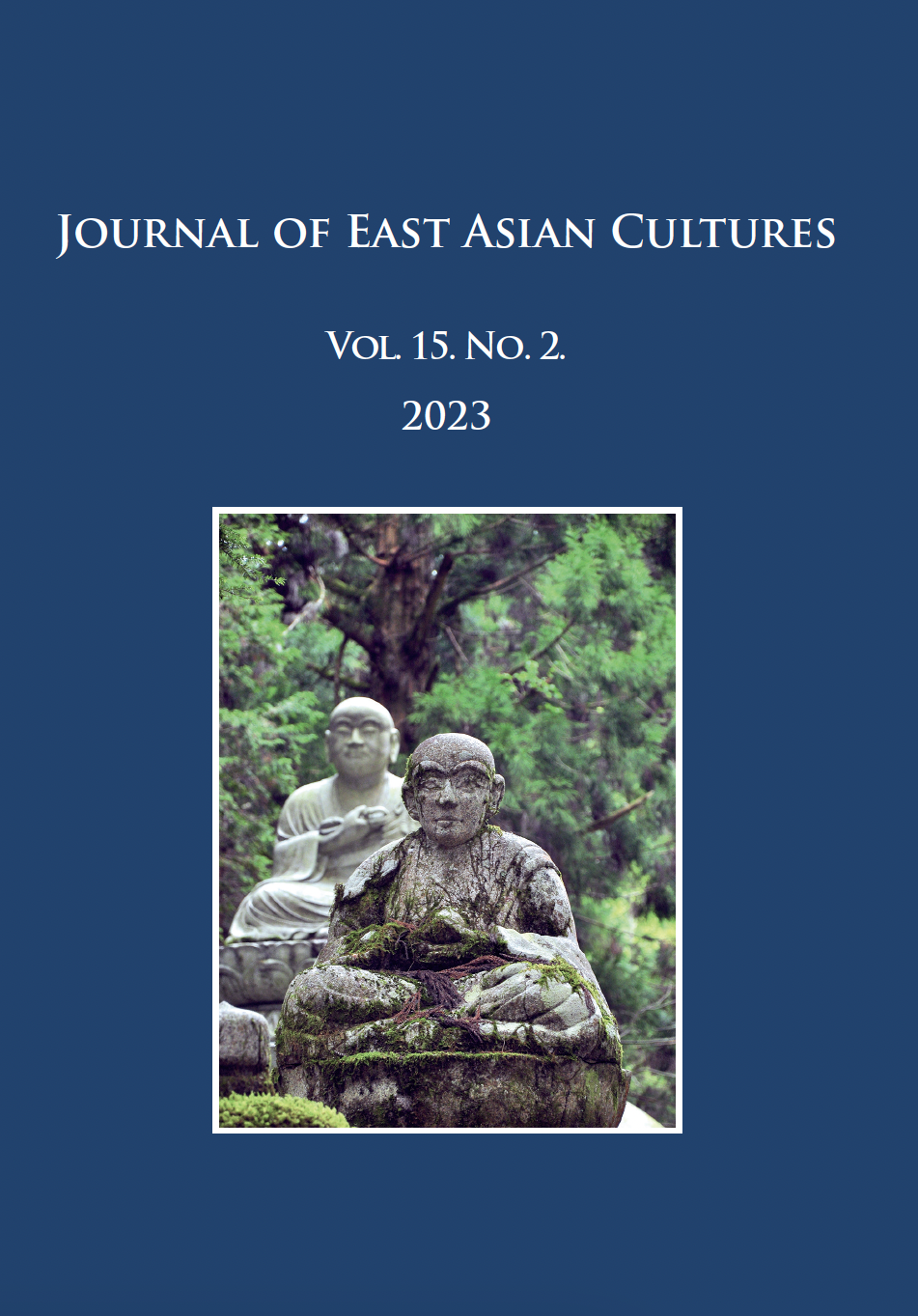The Huayan Understanding of One-mind and Buddhist Practice on the Basis of the Awakening of Faith
Megjelent 2023-09-30
Kulcsszavak
- A hit felkeltése a mahájánában,
- egy-tudat,
- Huayan,
- Zhiyan,
- Fazang
- Chengguan ...Tovább
Hogyan kell idézni

This work is licensed under a Creative Commons Attribution-NonCommercial 4.0 International License.
Absztrakt
The Huayan school of Chinese Buddhism inherited the legacy of the early transmission of Yogācāra teachings through the Dilun and Shelun schools, signifying a scholarly endeavour to synthetise the Yogācāra and Tathāgatagarbha teachings. In contrast to the Indian Yogācāra tradition, which was subsequently introduced to China by the renowned monk and traveller Xuanzang 玄奘 (602–664), these arly schools emphasised a kind of actual or pure reality behind the phenomenal world and was not satisfied with the worldview that the world can be traced back to a tainted entity, the ālayavijñāna, the source of all phenomena. This distinctive Chinese viewpoint finds explicit expression in the apocryphal Chinese text theAwakening of Faith Mahāyāna (Dasheng Qixin lun 大乘起信論), which has become one of the most important philosophical treatises in the history of Chinese Buddhism. This text proposes the concept of one-mind, which has the tathatā aspect (zhenru men 真如門) and the saṃsāra aspect (shengmie men 生滅門). Huayan exegetes, who authored commentaries on the Buddhāvataṃsaka-sūtra, the scripture that they regarded as the most perfect teaching of the Buddha, were influenced by the Awakening of Faith and the early Chinese Yogācāra schools in their understanding of this scripture. In this article, we are going to introduce the teachings of Buddhāvataṃsaka-sūtra that were interpreted as not only the appearance of Yogācāra thought but also as an unequivocal articulation of the concept of one-mind as it was put forward in the Awakening of Faith by Huayan scholars. We will show how this concept was further elaborated in Huayan philosophy and practice.
Hivatkozások
- T Taishō Shinshū Daizōkyō 大正新脩大藏經 [The Taishō Tripitaka]. Tokyo: Daizō Shuppansha,
- Vols. 1–55 & 85.
- Chen, Jinhua 2007. Philosopher, Practitioner, Politician: The Many Lives of Fazang (643–712). Leiden: Brill. https://doi.org/10.1163/ej.9789004156135.i-542
- Cook, Francis H. (trans.) 1999. ‘Demonstration of Consciousness Only.’ In: Three Texts on Consciousness Only (BDK English Tripitaka 60–I, II, III). Berkeley: Numata Center for Buddhist Transla¬tion and Research.
- Gimello, Robert M. 1976. Chih-Yen (602–668) And the Foundations of Hua-yen Buddhism. Ph.D. dissertation, Columbia University.
- Girard, Frédéric (trans.) 2004. Traité sur l’acte de foi dans le Grand Véhicule (The Izutsu Library Series on Oriental Philosophy 2). Tokyo: Keio University Press.
- Gregory, Peter N. 1991. Tsung-mi and the Sinification of Buddhism (Kuroda Institute Studies in East Asian Buddhism 16). Princeton: Princeton University Press.
- Guo, Cheen. 2014. Translating Totality in Parts: Chengguan’s Commentaries and Subcommentaries to the Avatamsaka Sutra. Lanham: University Press of America.
- Hakeda, Yoshito S. 1967. The Awakening of Faith Attributed to Aśvaghosha. New York: Columbia University Press.
- Hamar, Imre 2002. A Religious Leader in the Tang: Chengguan’s Biography (Studia Philologica Buddhica Occasional Paper Series 12). Tokyo: The International Institute for Buddhist Studies of The International College for Advanced Buddhist Studies.
- Hamar, Imre 2007. ‘A Huayan Paradigm for Classification of Mahāyāna teachings: The Origin and Meaning of Faxiangzong and Faxingzong.’ In: Imre Hamar (ed.) Reflecting Mirrors: Perspectives on Huayan Buddhism. Wiesbaden: Harrassowitz Verlag, 195–220.
- Hamar, Imre 2012a. ‘Deconstructing and Reconstructing Yogācāra: Ten Levels of Consciousness-only/One-mindin Huayan Buddhism.’ In: Robert Gimello – Frederic Girard – Imre Hamar (eds.) Avataṃsaka Buddhism in East Asia: Origins and Adaptation of a Visual Culture. (Asiatische Forschungen 155.) Wiesbaden: Harrassowitz Verlag, 53–71.
- Hamar, Imre 2012b. ‘The Metaphor of Painter in the Avataṃsaka-sūtra and its Chinese Interpretation,’ Huayen Study: The Integration of Classic and Contemporary, The 3rd International Conference on Huayen 1: 123–152.
- Hamar, Imre 2016. ‘Faith, Practice and Enlightenment in the Avataṃsaka-sūtra and the Huayan School.’ In: Imre Hamar – Takami Inoue (eds.) Faith in Buddhism. Budapest Monographs in East Asian Studies 6. Budapest: Institute of East Asian Studies, Eötvös Loránd University, 93–118.
- Jorgensen, John – Lusthaus, Dan – Makeham, John and Strange Mark 2019. Treatise on Awakening of Mahāyāna Faith. Oxford: Oxford University Press. https://doi.org/10.1093/oso/9780190297701.001.0001
- Kamata Shigeo 鎌田茂雄 1989. ‘Kegonkyō yuishinge kaishaku no bunken shiryō 華厳経唯心偈解釈の文献資料 [Bibliographical Sources for the Understanding of the Mind-Only Poem in the Avataṃsaka-sūtra],’ Nanto bukkyō 61–62: 146–182.
- Keng, Ching 2009. Yogâcāra Buddhism Transmitted or Transformed? Paramârtha (499–569) and His Chinese Interpreters. Ph.D. dissertation, Harvard University.
- Liu, Ming-Wood 1981. ‘The P’an-chiao System of the Hua-yen School in Chinese Buddhism,’ T’oung Pao 67.1–2: 10–47. https://doi.org/10.1163/156853281X00038
- Muller, Charles A. 1999. The Sutra of Perfect Enlightenment: Korean Buddhism’s Guide to Meditation (with Commentary by the Son Monk Kihwa). Albany: State University of New York Press.
- Paul, Diana Y. 1984. Philosophy of Mind in Sixth-Century China: Paramārtha’s ‘Evolution of Consciousness’. Stanford: Stanford University Press.
- Schmithausen, Lambert 2009. Plants in Early Buddhism and the Far Eastern Idea of the Buddha-Nature of Grasses and Trees. Lumbini: Lumbini International Research Institute.
- Tamaki Kōshirō玉城康四郎 1960. ‘Yuishin no tsuikyū – shisō to taiken to no kōshō 唯心の追求 ––思想と体験との交渉 [The Pursuit of Yuishin (Mind-Only) – Relationships of Thoughts and Experiences].’ In: Nakamura Hajime 中村元 (ed.) Kegon shisō 華厳思想, Kyoto: Hōzōkan, 335–418.
- Vorenkamp, Dirk 2004. An English Translation of Fa-tsang’s Commentary on the Awakening of Faith. Lewiston: The Edwin Mellen Press.
- Zhang Wenliang 张文良2017. Dongya fojiao shiye xia de huayan sixiang yanjiu 东亚佛教视野下的华严思想研究. Beijing: Guoji Wenhua Chuban Gongsi.

